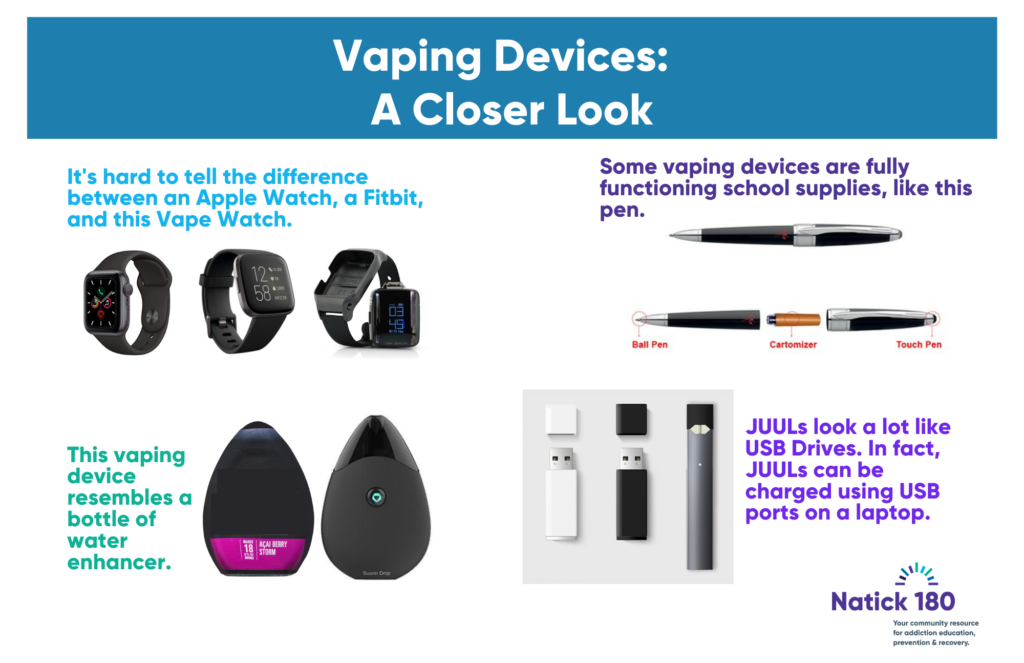Your community resource for addiction education, prevention, and recovery.
For an emergency, call 911
Tobacco, Nicotine & Vaping 101
- Home
- Addiction & Substances
- Substances 101
- Tobacco, Nicotine & Vaping 101
What you need to know:
Tobacco:
Tobacco contains nicotine, which is an addictive chemical. Many other chemicals can be found in tobacco products including formaldehyde, ammonia, and lead. Tobacco can be smoked through a variety of devices, chewed, or sniffed.
Nicotine:
Nicotine is an extremely addictive stimulant that is found in tobacco plants, making it really hard to quit once a person starts using.
Vaping:
Vaping (E-cigarettes, Mods, E-Hookahs, Tank Systems, JUULs) has become more popular in recent years, especially amongst youth. Although evidence suggests that liquid nicotine is a safer alternative to inhaling tobacco smoke, nicotine is still present in vaping products. These products also contain many dangerous chemicals that are found in traditional cigarettes. Youth use is extremely concerning because of the substantial impacts on the brain, which is not fully developed until age 25.

Looking to Quit Vaping?
For those struggling to quit using e-cigarettes, it may be particularly difficult. If you’re trying to quit vaping, try and practice the 4 D’s to help get through the urges of using.
See how to Practice the 4 D’s >
What are the risks?
The health risks of tobacco use are well known: lung cancer, heart disease, stroke, heart attack, pneumonia, and other cancers, to name a few. It can also prematurely age skin, stain teeth, cause bad breath and can impact both men and women’s sex lives. Pregnant women who smoke tobacco have an increased risk of stillborn births, premature births, and miscarriages and their children are at a greater risk for behavioral and learning issues.
Secondhand smoke also has many health risks. There is no safe level of exposure to secondhand smoke. People impacted by secondhand smoke are exposed to many of the same chemicals that smokers inhale. Secondhand smoke is a known cause for cancer and other health issues. Thirdhand smoke, a new phenomenon that researchers are still studying, is also a concern when it comes to e-cigarette usage. Thirdhand smoke occurs when the chemicals in the e-cigarette aerosol that is exhaled remain on surfaces, such as clothing, furniture, and other everyday items. Even if a person can’t see those chemicals, people can be at risk for touching and then ingesting those chemicals putting young children and pets in potentially dangerous situations. For more information on e-cigarettes and vaping, take a look at the Stanford Medicine Tobacco Prevention Toolkit.
There are many health risks that vaping products including decreased impulse control, issues with attention and learning, lung disease, and cancer among others. The aerosol or “vape cloud” that is eliminated from the products also has health risks similar to second-hand smoke in traditional cigarettes. The “cloud” contains formaldehyde and carcinogens.
Know the data:
In 2018, 10% of students have smoked a cigarette in their lifetime, and 4% smoked recently (in the past 30 days) compared to 36% of youth have used an electronic cigarette or other electronic vapor product in their lifetime, and 25% used electronic cigarettes in the past 30 days.
According to the 2017 Youth Risk Behavior Survey, 6.4 % of Massachusetts high school youth reported smoking cigarettes, but 20.1% of Massachusetts high school youth reported using an electronic nicotine delivery product (e-cigarette).
Each day in the U.S. about 2,000 youth under 18 years of age smoke their first cigarette and more than 300 youth under 18 years of age become daily cigarette smokers. Nearly 1 of every 5 high school students (20.8%) reported in 2018 that they used electronic cigarettes in the past 30 days—an increase from 1.5% in 2011.
Privacy Overview
| Cookie | Duration | Description |
|---|---|---|
| cookielawinfo-checkbox-analytics | 11 months | This cookie is set by GDPR Cookie Consent plugin. The cookie is used to store the user consent for the cookies in the category "Analytics". |
| cookielawinfo-checkbox-functional | 11 months | The cookie is set by GDPR cookie consent to record the user consent for the cookies in the category "Functional". |
| cookielawinfo-checkbox-necessary | 11 months | This cookie is set by GDPR Cookie Consent plugin. The cookies is used to store the user consent for the cookies in the category "Necessary". |
| cookielawinfo-checkbox-others | 11 months | This cookie is set by GDPR Cookie Consent plugin. The cookie is used to store the user consent for the cookies in the category "Other. |
| cookielawinfo-checkbox-performance | 11 months | This cookie is set by GDPR Cookie Consent plugin. The cookie is used to store the user consent for the cookies in the category "Performance". |
| viewed_cookie_policy | 11 months | The cookie is set by the GDPR Cookie Consent plugin and is used to store whether or not user has consented to the use of cookies. It does not store any personal data. |